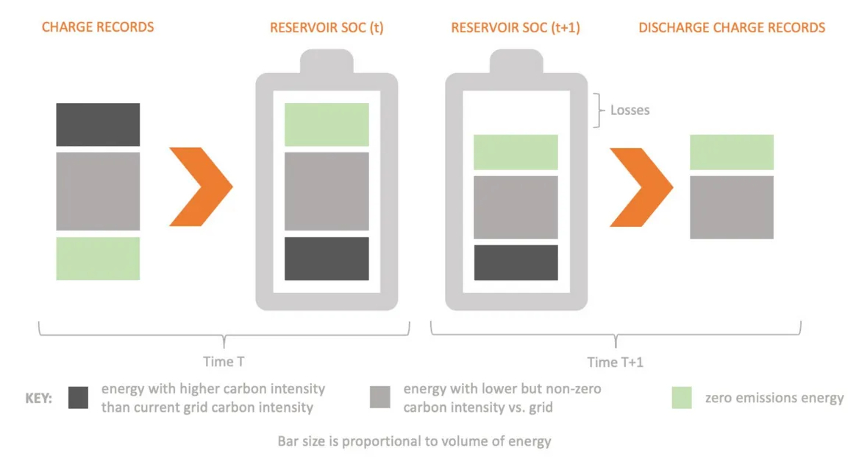Sign up for daily news updates from CleanTechnica on email. Or follow us on Google News!
A 2015 study by professors Eric Hittinger at the Rochester Institute of Technology and Inês Azevedo at Carnegie Mellon University found that US grid-scale batteries were, on balance, more likely increasing rather than decreasing emissions in the energy sector. That’s because grid-scale batteries charge when power is cheap and discharge when it’s expensive, but high and low power prices don’t necessarily correlate with high and low carbon emissions. Excess midday solar power can be cheap, but so can coal-fired power generated in the middle of the night when demand is low.
That’s a problem for companies like Google and Amazon that have made corporate commitments to lower the carbon intensity of their operations. It’s also a problem for regulators who are charged with implementing government policies that demand reductions in the emissions attributable to power generation.
Electrons are emissions-agnostic. An electron from a coal generating station is identical to and indistinguishable from an electron created by a solar panel or wind turbine. So how is it possible to know whether the electrons currently stored in any given grid-scale battery are emissions free?
EnergyTag is a UK-based non-profit that is addressing the need for certification of stored electricity. It has just released Version 2 of its Granular Certificate Scheme Standard. It should be pointed out that the word “scheme” has a rather different meaning in the UK than it does in the US. On the western side of the Atlantic, the word is a pejorative. It implies a certain deviousness or intent to deceive. On the east side of the Atlantic, it does not carry such sinister connotations. Its closest synonym is the simple word “plan.”
In the introduction to Version 2, EnergyTag says, “A Granular Certificate compliant with EnergyTag is a certificate relating to the characteristics of energyproduced during a period of one hour or less, issued in compliance with the requirements and rules of operation of the EnergyTag granular certificate scheme standard. This standard lays out the requirements that must be met in order to create an EnergyTag compliant granular certificate scheme.”
How Green Is My Electron?
Since an electron is an electron, and one electron is indistinguishable from another electron, how is it possible to certify that some are green and some are not? Time, it seems, is the answer. What EnergyTag does, stripped to its essentials, is record when electrons arrive at a grid-scale battery and match that information to what the predominant source of electricity is within the network that grid-scale battery serves at that time. If the energy coming in is green, then ipso facto the energy that goes out later will also be green.
That explanation is no doubt deficient in several respects, but it is as close as someone who is a writer rather than an engineer can make it. Canary Media delved more deeply into this topic recently with James Allan, senior director at Quinbrook Infrastructure Partners. On its website, Quinbrook says it is “led and managed by a senior team of power industry professionals who have collectively invested over $ 8.2 billion in energy infrastructure assets since the early 1990s, representing over 19.5 GW of power supply capacity. Our team brings an industrial perspective to investing in low carbon and renewables infrastructure.”
Quinbrook has just completed a testing program using the EnergyTag Version 2 software at the Byrd Ranch battery project in Sweeny, Texas, about 60 miles south of Houston. The 50 MW battery, owned by developer Glidepath, is actively charging and discharging power to the Texas grid in response to signals from energy market operator ERCOT. Such testing is needed to “credibly offer insights into where (energy consumers) are getting their power. Underpinning all that is being able to trace all these things on a credible, accepted standard.”
The technology used to implement the EnergyTag standard comes from Quintrace, an in-house platform Quinbrook launched last year to give customers “real-time visibility into their hourly carbon footprint.” Quintrace is one of a number of technology platforms now actively tracing the carbon emissions of power flowing from generators to end users across grids in the US and Europe as demand for granular emissions tracking grows. “We demonstrated you can trace the power through a battery on a sub-hourly basis,” Allan said, which “proved this is possible now.”
Emissions Tracking Software For Grid-Scale Batteries
To be clear, Byrd Ranch wasn’t always using clean power in its test. Instead, the software tracked a certain portion of its power coming from the grid as if it was being sent directly to the battery from a hypothetical solar farm with a typical solar project’s pattern of generation throughout the day to “simulate renewable energy slices within the battery,” Quinbrook says.
That power was intermixed with everyday grid power containing hour-by-hour carbon emissions intensity metrics provided by ERCOT. Quinbrook assumed that the battery used solar energy to charge whenever it was available from day to day and hour to hour, and used “slices” of grid power for the rest of its charging.
Keeping track of clean energy going into and coming out of a battery is complicated. The first trick is determining a commonly acceptable way to differentiate between “slices” of clean and dirty power. The time when batteries charge and discharge also complicates matters.
Some batteries may charge up days before they’re called on to discharge. Other batteries may be charging and discharging multiple times per hour. That latter mode of operations applies to the Byrd Ranch battery, which primarily provides fast-responsive services to ERCOT that can be called on every 4 seconds and measured for payment in 15-minute increments.
In these cases, “batteries are jumping around a lot within an hour,” Allan said. Proving just how clean each of those increments of power discharges is, based on records of charging that may have come minutes beforehand, is “a nontrivial problem.” “Nontrivial” is probably an understatement.
Batteries also face another challenge — “round-trip efficiency” losses. Even the most efficient lithium-ion batteries lose about 10% of the power coming into them compared to the power they can discharge. These losses come mainly from energy that is dispersed in the process of converting grid alternating current to direct current and back again when the battery is discharged to send power back to the grid. In addition, some power is used to operate the power conversion and control systems for the battery itself. Batteries also slowly discharge when at rest, a form of loss called “self-discharge.” Any system that tracks clean versus dirty power going into a battery must take these losses into account, as illustrated in this graphic.

Estimates & Accuracy
But the losses in any particular battery system “are estimates in most cases. They’re not hard numbers,” Allan said. Today, these figures are calculated based on metering how much energy goes into and out of a battery and combining that with a “state-of-charge” measurement. But these state-of-charge measurements are notoriously imprecise and can be subject to “errors due to temperature fluctuations, voltage plateaus across the state of charge, sensor calibration, and other data measurement issues,” Quinbrook says.
Finding ways to quantify and track these uncertain shifts in measured data from hour to hour is vital for any system that purports to accurately measure the emissions intensity of a battery. Without some method of catching erroneous measurements, “depending on how you carry that through the accounting process, you can have compounding errors and you can get an increasingly silly result,” Allan said.
Chip in a few dollars a month to help support independent cleantech coverage that helps to accelerate the cleantech revolution!
EnergyTag Verifies Grid-Scale Battery Emissions
The core goal of EnergyTag’s standards is to give power producers, buyers, and battery operators a clear understanding of how they’re accounting for the variables involved in treating batteries as a “reservoir” for “time-shifted” energy, Katrien Verwimp, EnergyTag’s audit committee chair, said when introducing the group’s latest standards.
Any system that asks power buyers to certify the emissions intensity of their electricity needs to “have clarity on recording all these attributes, and also taking a track or keeping track of the losses” at the batteries, she said. EnergyTag’s recently released Version 2 standard offers “much further detail than what went into the first version, but more testing in real world conditions is underway.” That testing is exactly what Quinbrook Infrastructure Partners is doing.
California was one of the first jurisdictions to issue regulations intended to ensure grid-scale batteries funded by a multi-billion dollar state incentive program would be operated in ways that lead to an overall reduction in grid emissions. But that program didn’t include standards for tracking charging and discharging as closely as the EnergyTag standard is taking on.
Google and Microsoft added to the demand for a way to include batteries in their carbon-free energy procurement goals to power their data centers with round the clock carbon-free energy by 2030. That in turn led Quinbrook to begin work on its Quintrace technology “as part of our green data center strategy,” Allan said.
In the past few years, government mandates have been added to these corporate pressures, he added — notably, the strict eligibility requirements for US and EU green hydrogen subsidies. Batteries will need standards like EnergyTag to play a role in providing some of the clean power that electrolyzers will need to meet strict hourly matching rules under the 45V hydrogen tax credit regime proposed by the Biden administration and similar clean energy rules for hydrogen producers in the European Union.
Allan expects more and more industries and governments will adopt hourly clean energy matching regimes as renewable energy supported by grid-scale batteries make up a majority of the electricity on grids in the US, Europe, and other nations. That’s when having standards and measurements that allow grid-scale battery operators to sign contracts and meet mandates to deliver carbon-free energy on demand will become more necessary and valuable.
“We’re solving difficult problems for green data centers and this is equally applicable to green commodities,” Allan said. “If you’re doing green hydrogen — or green steel, or green chemicals — you have to be able to support your green credentials.”
Have a tip for CleanTechnica? Want to advertise? Want to suggest a guest for our CleanTech Talk podcast? Contact us here.
Latest CleanTechnica TV Video
[embedded content]
Advertisement
CleanTechnica uses affiliate links. See our policy here.
- SEO Powered Content & PR Distribution. Get Amplified Today.
- PlatoData.Network Vertical Generative Ai. Empower Yourself. Access Here.
- PlatoAiStream. Web3 Intelligence. Knowledge Amplified. Access Here.
- PlatoESG. Carbon, CleanTech, Energy, Environment, Solar, Waste Management. Access Here.
- PlatoHealth. Biotech and Clinical Trials Intelligence. Access Here.
- Source: https://cleantechnica.com/2024/03/19/energytag-quinbrook-track-carbon-intensity-of-electricity-stored-in-grid-scale-batteries/





